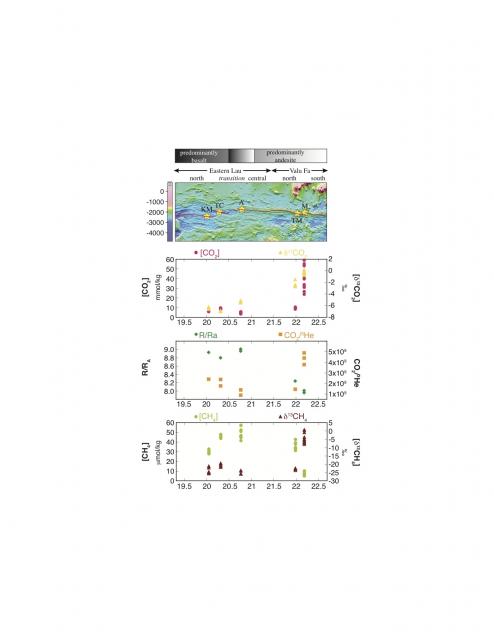Proskurowski
The Eastern Lau Spreading Center (ELSC) is oriented so that the southern sections of the ridge are closer to the Tonga Trench, and thus exhibit increasingly arc-like characteristics north to south. Most prominently, there is an abrupt shoaling of the ridge axis at around 20.5°S latitude (~2700m to the north, ~2200m to the south), a corresponding change in the primary rock type (basalts to the north, andesites to the south), and a much more consistent presence of an axial magma chamber to the south (Jacobs et al., 2007). In addition, the trace element geochemistry of the rocks from the ELSC shows to main groups, with the abrupt geochemical transition again occurring in the 20.5-21°S latitude region (Escrig et al., 2008). One important piece of data that does not perfectly fit with the notion of a rapid transition between MORB-dominated and arc-dominated upper crustal sections is the d13C-CO2 values from vent fluids. There are six known active hydrothermal sites along the ELSC/ValuFa ridge (from north to south: Kilo Moana, Tow Cam, Tahi Moana--discovered by the Chinese in 2007, ABE, Tui Malila, Mariner, and Vai Lili), where Tahi Moana and Abe occur at ~2200m, just south of the major transition. The carbon-13 isotope ratios of CO2 sampled form these fluids exhibit an extremely linear trend from a typical basalt-hosted value of -6‰ at Kilo Moana, to a typical arc-influenced value of 0‰ at Mariner. This may suggest that the hydrothermal fluids may be integrating the full upper-crustal section, and that the surface rocks may not be the whole story. Assuming this--that there is a smooth rather than abrupt gradient in melt geochemistry—perhaps there is some chemical threshold at which the physical eruptive expression of melt abruptly changes.

